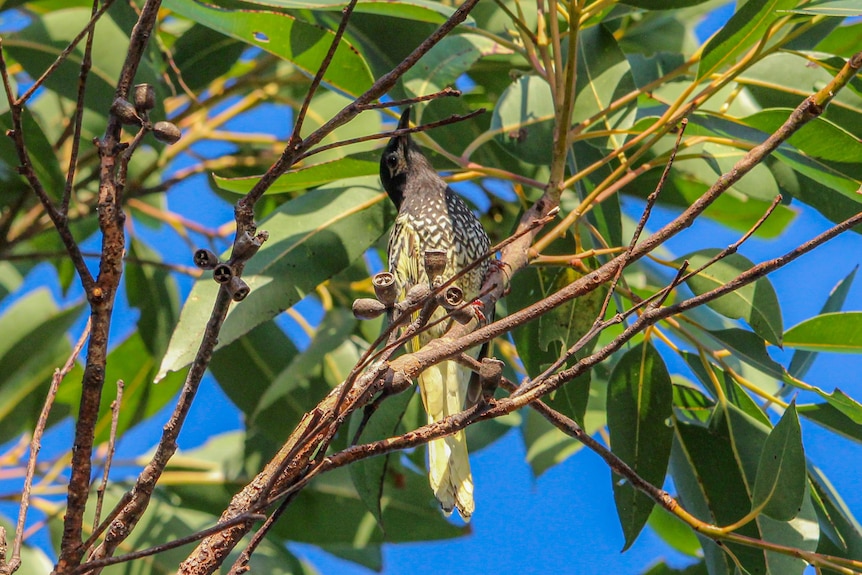
A regent honeyeater spotted north of Coffs Harbour this week.(Supplied: Peter Smith)none
This is our daily post that is shared across Twitter & Telegram and published first on here with Kindness & Love XX on peace-truth.com/
#AceNewsRoom in Kindness & Wisdom provides News & Views @acenewsservices

Ace Press News From Cutting Room Floor: Published: Jul: 0.1: 2023:
#AceNewsDesk - One of Australia's rarest species of bird, the critically endangered regent honeyeater, has been making an appearance in several locations along the New South Wales east coast.

A regent honeyeater spotted north of Coffs Harbour this week.(Supplied: Peter Smith)none
Conservationists say it's "heartening" news, as last breeding season they were unable to find any regent honeyeater nests.
"The current regent honeyeater population estimate is around 250 to 300 birds in the wild, and with not seeing a single nest last year, you would err towards the lower end of that estimate," Birdlife Australia's NSW Woodland Bird Program manager Mick Roderick said.
This week there have been sightings of the distinctive honeyeater near Coffs Harbour on the state's Mid North Coast, and a flock has been seen further south at Lake Macquarie in the Hunter region.
"We have a couple of birds found in recent days, north of Woolgoolga, feeding on flowering swamp mahogany, and at the same time we have had up to a dozen birds in Lake Macquarie also feeding in swamp mahogany," Mr Roderick said.
"It's fantastic … 12 birds in Lake Macquarie makes it the largest winter flock we have had there since 2011, so it's really heartening news."
Breeding under the radar
Once more widespread, regent honeyeaters are now found from north-east Victoria to south-east Queensland.
Mr Roderick said earlier this year when survey teams were unable to locate any nests, the future of the species seemed dire.
"It was a season where we didn't actually witness any successful breeding, and that was the first time that had happened, and that was a real concern," he said.
"For many years the Capertee Valley [near Lithgow] was always the stronghold for the bird … but we couldn't even find them in the Capertee Valley."A juvenile regent honeyeater is rare evidence of successful breeding in 2022.(Supplied: Tim Paasila)none
While the lack of visible breeding locations again highlighted the plight of the species, two juvenile regent honeyeaters were finally spotted in March in a location the birds had not been seen before.
It was near the site of the latest release of captive-bred regent honeyeaters in the Lower Hunter region.
A captive breeding and release program has been running for more than 20 years in Victoria and NSW to ensure the species' survival and supplement the wild population with zoo-bred birds.
"After our latest release of captive-bred birds in the Lower Hunter region, we were able to put some new radio transmitters [designed to fall off] on some of the Taronga Zoo-bred birds, which enabled us to keep monitoring the birds for longer," Mr Roderick said.One of the birds fitted with a transmitter after being seen in the Hunter this year.(Supplied: Mick Roderick)none
"In early March we made a discovery that some of them were feeding in a new habitat type, dominated by banksias, in Werakata State Conservation Area, in a habitat called Kurri Sand Swamp Woodland.
"We also found two baby regent honeyeaters in that area; one of the birds we think was about four months old, the other was about eight months old, so they had both hatched in different broods in the 2022 breeding season.
"So, it wasn't as disastrous as we had thought … these birds are hanging on somewhere, so it gives us a bit of optimism."
Birdwatchers urged to keep a look out
Monitoring of regent honeyeaters continues throughout the year and members of the public are also encouraged to report sightings to Birdlife Australia.A regent honeyeater on the NSW Mid North Coast this week.(Supplied: Peter Smith)none
"Birdlife is very eager to put the word out that regent honeyeaters are wintering along our coastline, and we would be delighted if the community could help out by doing some searches and assist in finding some regent honeyeaters," Mr Roderick said.
"The breeding season is just around the corner, they will breed as early as late July and into August onwards, so we are really keen to try and find where these birds are.
"Regent honeyeaters are probably the most mobile of all the honeyeaters; you usually only find them where there's lots of blossoms and the trees are high nectar-yielding trees ... they are quite fussy."
Nest protection
Efforts are underway to protect nesting sites.(Supplied: Mick Roderick)none
Efforts are also continuing to refine ways to protect nests from predators, such as possums, including the use of collars on branches.
"Nest predation happens from a number of bird species, and also things like brushtail possums, squirrel gliders and sugar gliders will predate a nest," Mr Roderick said.
"We just can't afford for that to happen; regent honeyeaters can't withstand the loss of nests."
FEATURED ABC NATURE & ENVIRONMENT NEWS REPORT
Editor says …Sterling Publishing & Media Service Agency is not responsible for the content of external site or from any reports, posts or links, and can also be found here on Telegram: https://t.me/acenewsdaily and thanks for following as always appreciate every like, reblog or retweet and comment thank you

@acenewsservices
No comments:
Post a Comment